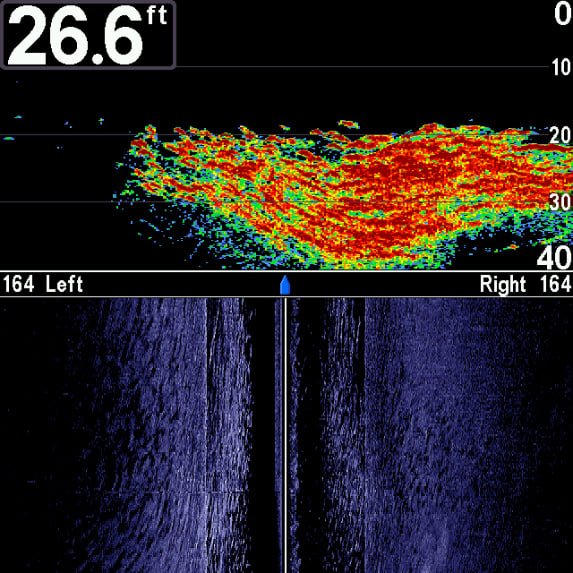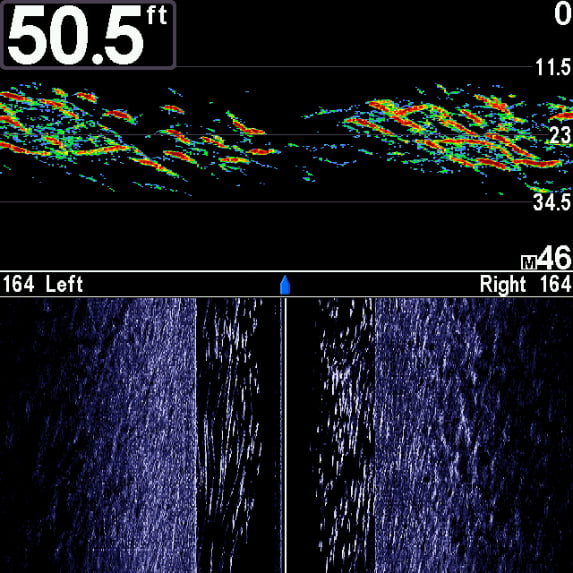Sonar has helped me tremendously, and it's definitely made finding and catching fish much easier. However, a part of me wishes that sonar did not exist.
I feel that the “old school” fishing knowledge that was centered around wind, tides, weather, and a certain kind of “instinct” is no longer as important as it once was, prior to sonar coming onto the scene.
Sonar makes catching fish much, much easier. Yet as we discussed in Understanding Your Sonar 101, just having a sonar on your boat is no guarantee that you’ll find and catch fish. There’s a lot more to it.
In this post, I will share with you some more advanced ideas and techniques for finding and catching fish using side-scan sonar.
Podcast Deep-Dive
For those you who prefer to listen instead of read, we've created a podcast version of the content discussed in this post. Simply press play below to listen-in! 🐟
Side-scan Sonar Basics

In the upper half of this snapshot is a school of bass on the regular sonar. Below is the same school on the sidescan, marking on both the port and starboard.
Side-scan sonar shoots off to the port and starboard side of your boat, and marks fish and structure. Side-scan works very well in conjunction with regular sonar, which shoots directly beneath your boat.
It is difficult to mark fish with side-scan when traveling at speeds which create a lot of bubbles and disturbance from the engine.
For example, I have had my best success marking fish using side-scan when traveling at trolling speed, however I can also mark fish when traveling at 10mph, because the pitch of my boat offers the side-scan sonar beams a clear shot with no bubbles or disturbance from the engine.
Engine disturbance on my boat becomes too great at speeds higher than 10 mph, and due to the pitch of my boat, side-scan doesn't work well for me when traveling between 3-8mph. The moral of the story is that trolling speed generally works well on all boats, but you'll have to experiment with how your boat and side-scan work when traveling at higher clips.
What Do Fish Look Like On Side-Scan?
Fish will appear as white lines on side scan. Schools of fish will appear as many individual white lines. In many instances the size of the white lines does indicate the size of the fish.
For example, short white lines are often schoolies or bluefish, while big white lines are 25 plus pound stripers.

You can often even count the amount of fish in a school by counting the white lines.
Also, in some situations you may just catch sight of the side-scan sonar “shadow” and not the white line. Yet the shadow also indicates that a fish was marked, so keep your eyes open for both the white lines and any shadows.
Best & Worst Situations For Sidescan Sonar
In my opinion, side-scan works best in deep water during calm conditions. I get super clear and clean markings in this type of situation.
Side-scan also works well in shallow water areas when it is calm. I can mark fish, as well as weed beds, rocks, boulders and other structure using side-scan sonar in shallow during calm conditions.

Side-scan does not work very well for me in rough conditions. My boat pitches up and down in rough conditions, which causes bubbles and disturbs the side-scan sonar readings. There’s often so much clutter and noise on the side scan that I will not even use it when it’s rough.
I have also not received much benefit from using side-scan in areas where the bottom undulates greatly. In one particular spot I often fish, bass settle down into the troughs of large underwater “sand dunes”.
The side-scan is useless here because the sonar beams bounce off the crests of the underwater “sand dunes” and just can’t get to the bass which are holding in the troughs.

In this situation the regular sonar is all I use.
Using Sidescan To Catch More Fish
So how exactly can you utilize side-scan sonar to put a few more nice fish in your boat?
Here’s two specific ways side scan can help:
1) Side scan will mark fish holding shallow, which you would miss using just your regular sonar.
Because your regular sonar shoots directly beneath your boat in a cone shape, you will rarely mark many fish that are holding shallower than 15 feet beneath the surface. The cone shape of the regular sonar beam simply does not allow it.
Yet with side-scan sonar you can mark fish that are holding just beneath the surface, and even fish that are working right on the surface. Big bass will sometimes focus on the upper portion of the water column, and without side scan you could miss out on these fish.
2) Side scan shows you what side of the boat most of the fish are on.
With regular sonar you may mark a big school of fish beneath your boat. Well, at least it appears as if that big school of fish is directly beneath your boat.
Truth is that the school may be slightly off to the port or starboard. With side scan you will see exactly what side of the boat the majority of the fish are holding on.

If you’re casting plugs or bait this can be useful, because you’ll know what side of the boat is best to cast at.
You may also pick up on the general direction that the school is moving. If you are drifting through a school of fish you may see that the school is first on your port, then passes beneath the boat, and then disappears to the starboard.
Now you at least know the general direction the fish are moving.
In Conclusion
I feel that side-scan is worth the extra money, especially right now because the price has come way down, compared to how much side scan cost 10 years ago.
What specific questions do you have with regards to side scan sonar? Let me know by commenting below.
Tight lines!




The one thing I don’t think i have ever done is run a sonar and sidescan screen comparatively I can’t believe i haven’t done it
The sidescan is definitely a game changer. Once you get the hang of it, it’s incredibly useful.
I just bought a Garmin 106 sv and worry about where to mount it. I plan to put it in the bow where I’ll bee fishing from. Pros and cons of trolling motor mounts? Cost of a transducer pole is fairly expensive.
Thanks for the comment Patrick! Unfortunately I don’t have any personal experience using trolling motor or transducer pole mounts.
Thanks for the excellent side scan info Ryan. I haven’t been very happy with my Garmin side scan but you given me some things to look at.
I’ve heard Hummingbird may have the best small unit side scan and your pictures support that to me.
Humminbird has been in the side scan business for at least 10 years now, and I’m really happy with the value provided by my Humminbird 798si. LMK if I can help with anything else, and thanks for reading the article. Tight lines Steve! ?
Hi Ryan, Each of your much appreciated pics are boosting my confidence learning to read my new world of Lowrance hook2. Westerly winds recently and the new moon drew fish in shallow at night catching a variety of size fish up to 45 lbs by instinct/luck but couldnt see fish in 6 feet of water in the side scan. Can I adjust the frequency to change the angle of the cone, or is seeing fish in the side scan at that depth just a dream, or can you offer any other advice? grasshopper Joe
Wow Joe, that sounds like an awesome night of fishing!
I regularly mark fish with my sidescan in as little as 2ft of water. I have a Humminbird 798si, and I’m not familiar with your Lowrance unit, but I would think it should be able to mark fish in less than 6ft of water. There’s got to be some setting you can play with to get it working.
Keep me posted and gluck! ?
Hi Ryan,
Thanks for the informative lesson on side-scan sonar. I have a Garmin EchoMap Chirp 94sv with a transom-mount transducer on my Seaswirl Striper 2100 WA. Do you ever experience side-scan interference issues with your outboard prop/skeg? Is there an optimal place to locate the transducer?
Thanks,
Rick Kennedy
Hi Rick ?
Yes I do experience interference with my side scan.
The starboard side reads very clear, however the port side experiences some interference. That’s because of where my transducer is installed. See below. ?
My engine gets in the way and interferes with the port side sonar beam, but I would still say the spot where I have my transducer is the optimal spot.
Are you experiencing a lot of interference? Do you have your transducer in roughly the same spot?
Thanks for the quick reply Ryan. Yes, that’s about where my transducer is mounted, but on the other (i.e. port) side. When I get interference on the starboard side, I just trim the motor up a little, but I wasn’t sure if there was a better solution.
Thanks again,
Rick
Roger that Rick. I do the exact same thing to help fight against interference. I’ll just adjust my speed and prop until I get as clear a reading as possible.
Hi Ryan, have a 741xs with sidescan on my 14 foot aluminum “Just Enough”. Haven’t used it because I didn’t understand how to read it. Your article changed that…thanks.
P.S. went on trip with you and Cullen May 2018 for sea bass. I know tuna trips have been canceled because of whether. If there is an opening, even last minute, let me know.
Jacques Morin 508-776-2953
Great to hear that Jacques! I’m sure you’ll have fun figuring out the sidescan and you will definitely benefit from learning how to use it. ?
I’ve been pretty busy recently, hence why I’ve been slow to organize group tuna trips with Cullen. If something opens up I will be sure to let you and the other members know ASAP. In the future I think I will schedule all group trips ahead of time during the offseason, because things get pretty hectic (in a good way!) during the fishing season.
Look forward to hearing if anything opens up. I know the window is narrowing! ?